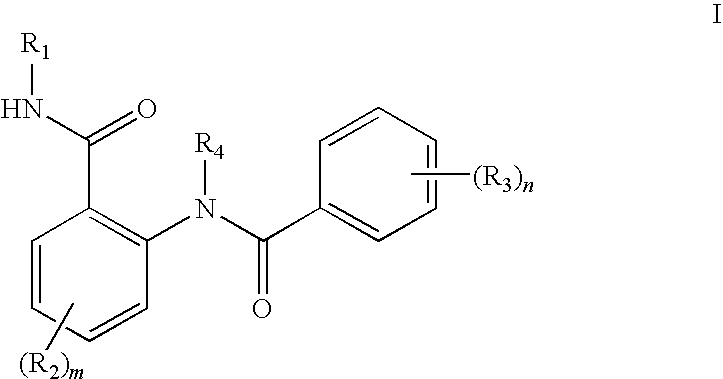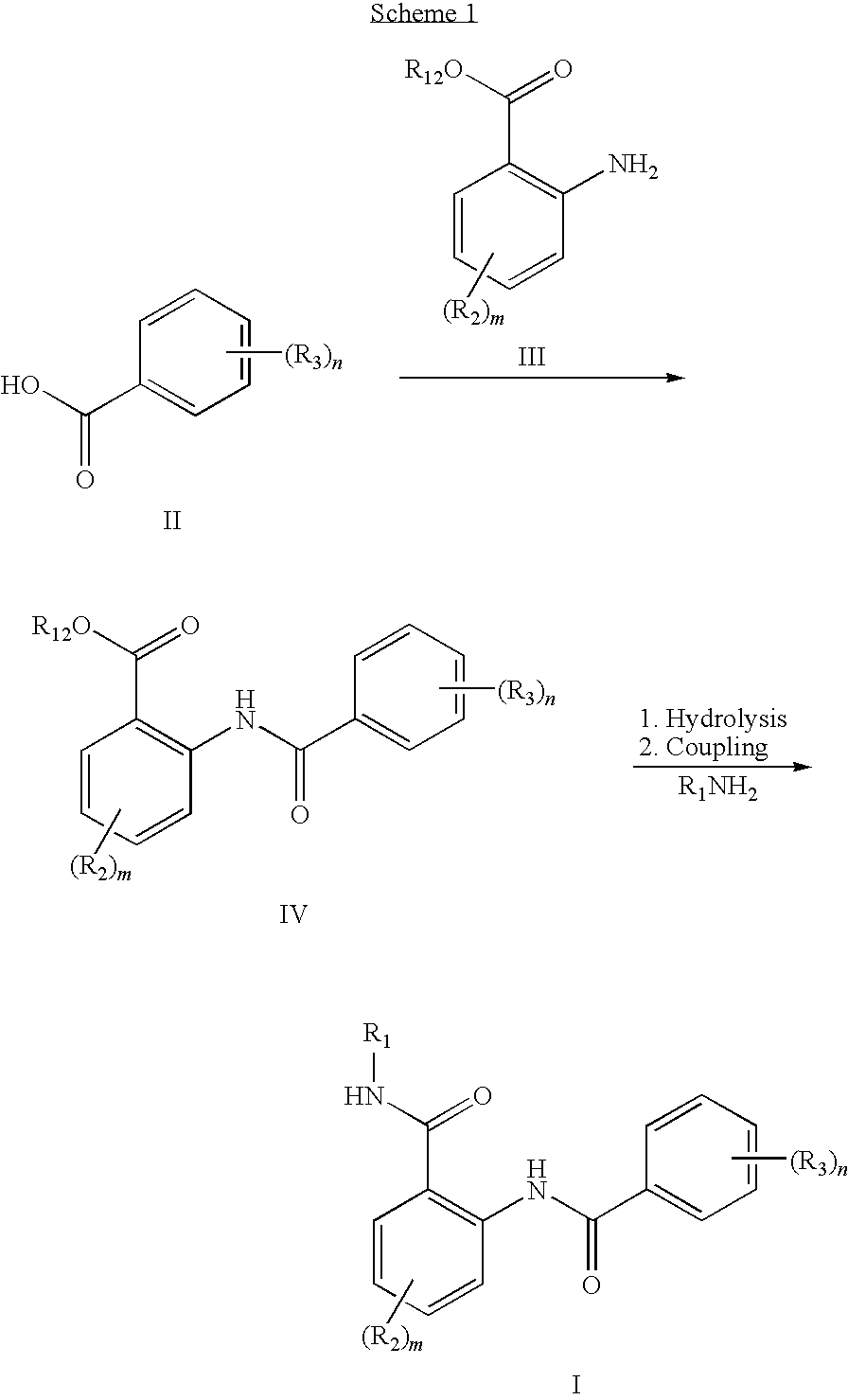Anthranilic acid derivatives as inhibitors of 17beta-hydroxysteroid dehydrogenase 3
an analogue and inhibitor technology, applied in the field of anthranilic acid derivatives, can solve the problems of refractory treatment of patients, large response restriction, and interference of lhrh analogues with central nervous system feedback mechanisms
- Summary
- Abstract
- Description
- Claims
- Application Information
AI Technical Summary
Problems solved by technology
Method used
Image
Examples
example 1
2-[(3-chloro-4-hydroxybenzoyl)amino]-N-[2-(2-methoxyphenyl)ethyl]-5-phenoxybenzamide
[0142]
1A. Preparation of methyl 4-(3,4-dimethoxybenzyloxy)-3-chlorobenzoate
[0143]
[0144]A solution of (3,4-dimethoxyphenyl)methanol (6.0 g, 40 mmol) (Aldrich Chemical Co., Milwaukee, Wis.) and methyl 3-chloro-4-hydroxybenzoate (2.5 g, 13.5 mmol) (Lancaster Synthesis Ltd, Windham, N.H.) in THF (100 mL) was cooled to 0° C. and treated with triphenylphosphine (8.8 g, 33.5 mmol). A solution of diethylazodicarboxylate (5.3 mL, 33.5 mmol) in THF (50 mL) was added dropwise over 30 minutes. After the addition was complete, the reaction was warmed to room temperature and stirred for an additional 30 minutes, and then concentrated to orange oil. The crude reaction was applied directly to a silica column and flushed with hexanes. The desired product was eluted from the column using 25% EtOAc in Hexanes to afford 1A as a light yellow solid (2.5 g, 56%).
1B. Preparation of 4-(3,4-Dimethoxybenzyloxy)-3-chlorobenzoic...
examples 2-8
[0155]Examples 2-8, which are set forth in Table 1 hereinbelow, were prepared in accordance with the procedure utilized in preparing Example 1.
[0156]
TABLE 1HPLC RetTimeEx. No.R1R2Compound Name[M + H](min)a2H3-chloro-4-hydroxy-N-[2-({[2-(2- methoxyphenyl)ethyl]amino}carbonyl) phenyl]benzamide4253.583—OPh2-[(3-chloro-4-hydroxybenzoyl)amino]- N-ethyl-5-phenoxybenzamide3662.594—OPh2-[(3-chloro-4-hydroxybenzoyl)amino]- N-[2-(2-chlorophenyl)ethyl]-5- phenoxybenzamide5213.415H3-chloro-N-{2- [(ethylamino)carbonyl]phenyl}-4- hydroxybenzamideNA3.046H3-chloro-4-hydroxy-N-(2-{[(2- phenylethyl)amino]carbonyl}phe- nyl)benzamide3953.517H3-chloro-N-[2-({[2-(2- chlorophenyl)ethyl]amino}carbonyl)phe- nyl]-4-hydroxybenzamide4293.668—OPh2-[(3-chloro-4-hydroxybenzoyl)amino]- 5-phenoxy-N-(2-phenylethyl)benzamide4873.22aHPLC Conditions: YMC S5 ODS 4.6 × 50 mm, 10-90% aqueous methanol containing 0.2% H3PO4, 4 min gradient, monitored at 220 nm).
example 9
Preparation of Formula 9G compounds
[0157]
wherein R1 is selected from the various R1 groups identified in Tables 2 and 3; and R2=OMe, OPh, or H.
[0158]Example 9 is directed to the general library synthesis procedure that was utilized in preparing Examples 10-33, which are set forth in Tables 2 and 3 hereinbelow.
[0159]IRORI MicroKans™, which can be purchased from Discovery Partners Int. (San Diego, Calif.), are made of high-grade polypropylene with polypropylene mesh in the sidewalls and cap. Each MicroKan™ is loaded with a unique radiofrequency tag (RF tag) that is used to track the synthesis sequence for each MicroKan™. Each MicroKan™ is also loaded with resin beads. The synthesis sequence is carried out on the resin beads. Each MicroKan™ has a volume of 250 uL and can hold up to 31 mg of resin. The mesh sides and lid of the MicroKan™ allow reagents and solvents to interact with the resin inside the MicroKan™. Prior to each synthesis step with a new building block reagent (e.g. anthr...
PUM
| Property | Measurement | Unit |
|---|---|---|
| total volume | aaaaa | aaaaa |
| pH | aaaaa | aaaaa |
| pH | aaaaa | aaaaa |
Abstract
Description
Claims
Application Information
 Login to View More
Login to View More - R&D
- Intellectual Property
- Life Sciences
- Materials
- Tech Scout
- Unparalleled Data Quality
- Higher Quality Content
- 60% Fewer Hallucinations
Browse by: Latest US Patents, China's latest patents, Technical Efficacy Thesaurus, Application Domain, Technology Topic, Popular Technical Reports.
© 2025 PatSnap. All rights reserved.Legal|Privacy policy|Modern Slavery Act Transparency Statement|Sitemap|About US| Contact US: help@patsnap.com



